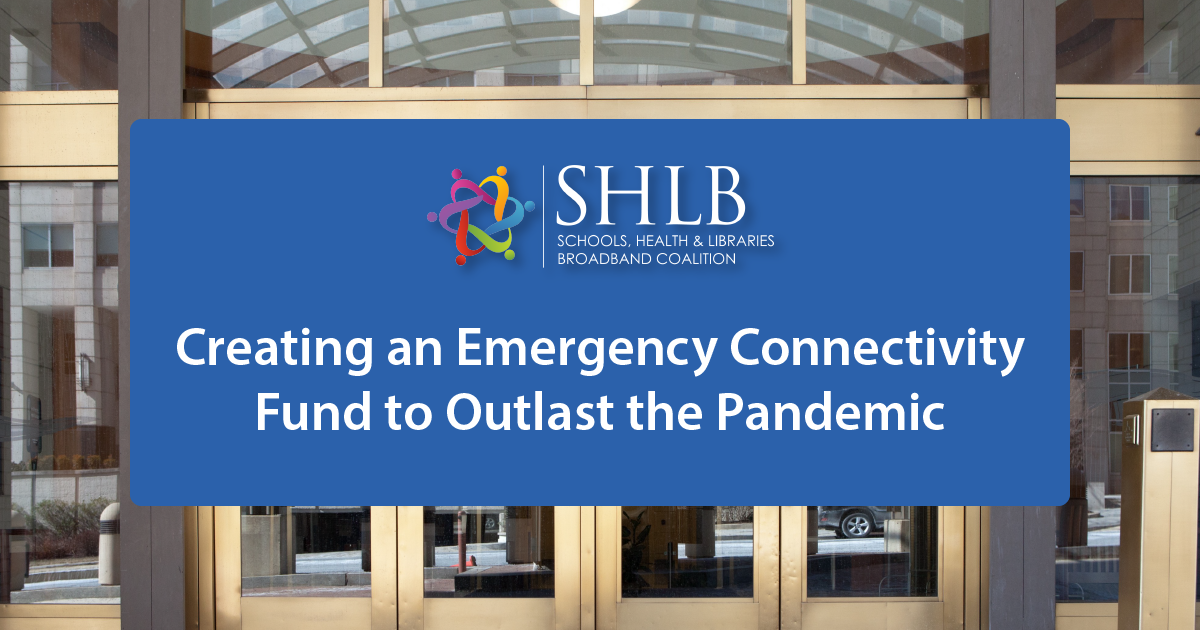Creating an Emergency Connectivity Fund to Outlast the Pandemic April 16, 2021
By John Windhausen, executive director, SHLB Coalition; with assistance from Bailey McHale, intern and Abigail Simmerman, intern, SHLB Coalition
The recently-approved American Rescue Plan Act (ARPA) allocated $7.171 billion to a new Emergency Connectivity Fund (ECF), an historic expansion of the E-rate program to connect students, teachers, and library patrons who lack home broadband access. As the SHLB Coalition proposed in a Remote Learning Petition filed earlier this year, the ECF will fund broadband connections and devices off-campus, setting it apart from traditional E-rate dollars.
Eager to connect their communities, schools and libraries have a lot of reasonable questions at this stage: Can they deploy brand-new networks? Will the ECF pay for out-of-pocket solutions procured in 2020? Will there be a budget cap? Will they have to go through a competitive bidding process? The Federal Communications Commission is still collecting comments on how to establish the ECF, but it only has 60 days to develop the program rules, so we will know the answers to these questions in just a few weeks.
The SHLB Coalition believes the FCC should create an ECF program that focuses on long-term connectivity solutions so that those without home broadband today can stay connected long after the pandemic subsides. After all, even when physical buildings reopen, students and patrons will need the internet off-campus to do homework and research. We also suggest that the ECF should complement, rather than duplicate, the Emergency Broadband Benefit program, which aims to provide short-term relief for low-income households.
In our ECF comments, SHLB proposed several recommendations that will allow broadband deployment “to and through” a school or library building to reach the surrounding community. While hotspots can solve student connectivity woes quickly in some areas, many regions cannot support these devices. This is where deploying new fiber and wireless networks “to and through” schools and libraries would come in handy, by encouraging anchor institutions to build out new networks to reach the home, using, for example, new and affordable wireless technologies.
The ARPA listed five examples of eligible equipment that the ECF must include, but it’s imperative that the FCC not limit eligibility to this list alone. There are many other services that could benefit residential consumers, such as fiber and wireless technologies. Restricting the ECF to already-existing networks would neglect the vast numbers of students and library patrons who don’t have home broadband because it simply doesn’t exist in their location. The House Commerce Committee report language encourages the FCC to support “different technological solutions.” That includes construction of new networks.
“To and through” is more than just a hypothetical solution. In fact, anchor institutions around the country are actively employing the strategy to combat the digital divide in their communities. A few examples:
- Salt Lake City, Utah: The Murray City School District created a private long-term evolution (LTE) network using Citizens Broadband Radio Service (CBRS) that provides internet to 6,000 students, at no cost to families. This dedicated, centrally-managed cellular network will keep students attending class sessions, studying, and completing assignments, all separate from other at-home traffic. Murray intends for the network to last beyond the pandemic.
- Dallas, Texas: The Dallas Independent School District is putting up towers to broadcast internet service for free to students in need. Five towers, which cost about $500,000 each, propagate the district’s fiber-optic network into neighborhoods with high levels of need, determined by students on free and reduced lunch programs. Officials hope to build permanent infrastructure for the community for post-pandemic life.
- Brooklyn, New York: Nearly 30 percent of all Brooklynites have neither home nor mobile broadband, so the Brooklyn Public Library began BKLYN Reach. The program installs rooftop antennas on libraries to boost each building’s Wi-Fi signal an additional 300 feet beyond the walls, with every installment reaching between 1,100 and 3,600 people.
Beyond allowing a broad range of technologies to qualify for funding, SHLB also suggested that the ECF adopt budget caps similar to those employed in E-rate Category Two funding. Funds For Learning and E-rate Central posit that this approach would safeguard the program from waste, fraud, or abuse while simultaneously getting funds out the door expediently. Furthermore, setting a fixed amount of funding per school district or library empowers each institution to determine the best way to connect their own community without fear of draining the fund.
While the top priority for the ECF is to connect students and library patrons for the duration of the pandemic, there’s no reason schools and libraries shouldn’t pursue longer-term solutions. The statutory language makes funding available from January 2020 through the year 2030, which suggests that the ECF is the time, place, and fund to explore creative options for diminishing the homework gap in the long run.


